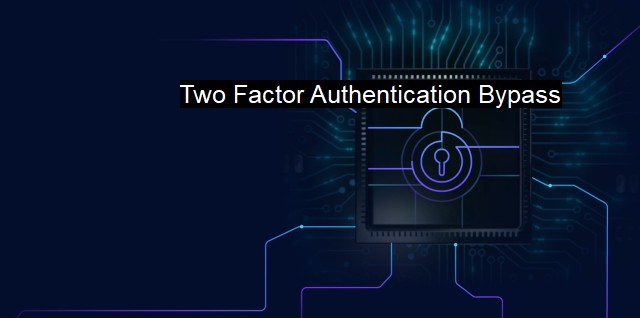What are Two Factor Authentication Bypass?
Exploring the Vulnerabilities of Two Factor Authentication and the Techniques of Two Factor Authentication Bypasses: Understanding the Risks and the Prevention Measures
Two-factor authentication (2FA) is a crucial component of modern cybersecurity architecture. It is a security feature that requires end users to verify their identity through two separate elements: something they know (like a password) and something they have (like a mobile device to receive an SMS code). The whole goal is to provide an extra layer of security, making it harder for potential intruders to gain access to a person's devices or online accounts because they would not only need to know the user's password, but also have their mobile device.With rising cyber threats and increasingly sophisticated cyberattacks, dual layers of security measures are sometimes not enough, and this gave rise to the concept of Two-Factor Authentication Bypass.
Two Factor Authentication Bypass is a technique exploited by cybercriminals to overcome the additional protection provided by 2FA. Cybercriminals proficient in Two Factor Authentication Bypass can decipher both layers of security, gaining unauthorized access to user's confidential data and potentially leading to dire consequences such as identity theft, data manipulation or unauthorised monetary transactions.
One common technique of Two Factor Authentication Bypass is called Man-in-the-Middle (MitM) attacks, where infiltrators insert themselves between two parties online. Having invisibly intercepted communication, they can manipulate the interaction to their advantage.
For instance, when a user attempts to log in to an account, As part of the 2FA, a password and a unique security code is sent to the user's mobile device. In a MitM attack, the attacker intercepts this communication, obtaining the unique security code, allowing them to login with ease. The victim is led to believe they have simply failed trying to login, none the wiser about the hidden cyberattack.
Another method cybercriminals use to bypass 2FA is SIM swapping. Here, the attacker convinces the mobile network operator that they are the actual owner of the phone number (through tactics like social engineering) and gets the robot calls or SMS of the OTP (One-Time Password) for 2FA redirected to their own device. With this, they can hence bypass the 2FA of the actual owner's account.
Phishing is also another worrying method for deceiving users into entering both their passwords and 2FA codes into fraudulent websites while the attacker collects data in real-time, unbeknownst to the user.
Two Factor Authentication Bypass is, indeed, a clever and stealthy method leveraged by cybercriminals, but measures can be taken against it. One of the best ways to counter the risk is to regularly educate users about the threat of phishing and cyber hygiene to strengthen security on the users' end.
In response to the rising threat, superior techniques are being developed, like biometrics, physical security keys, hardware authentication. Security experts are now also talking of Multi-Factor Authentication (MFA) instead of just 2FA, introducing extra layers of security for user verification to ensure safer cyber transactions in the time of hackers relentlessly trying to find loopholes.
We must not underestimate the dangers posed by Two Factor Authentication Bypass. Cybersecurity is an ongoing process and must continually evolve — we need to stay ahead as cybercriminals become more sophisticated and innovative. It is both the responsibility of individuals and organizations to uphold their digital security, employ robust security measures and stay vigilantly aware of the latest cybersecurity threats and trends.

Two Factor Authentication Bypass FAQs
What is two factor authentication bypass and how does it work?
Two factor authentication bypass is a process of circumventing the two factor authentication security measures that are in place to protect accounts. This can be done through various methods such as social engineering, phishing, SIM swapping, or exploiting vulnerabilities in software or hardware.How can I protect myself from two factor authentication bypass attacks?
To protect yourself from two factor authentication bypass attacks, you should enable two factor authentication with a reliable service provider or app, use strong and unique passwords, be cautious of suspicious emails or messages, avoid using public Wi-Fi, and keep your software and hardware up to date with security patches.What are the risks of using two factor authentication?
While two factor authentication increases security, it is not foolproof and there are still risks involved. Two factor authentication can be bypassed through various methods and it can also create inconvenience for the user, such as when they do not have access to their second factor device.What should I do if I suspect my account has been compromised through two factor authentication bypass?
If you suspect your account has been compromised through two factor authentication bypass, you should immediately change your password, disable access to your account from unauthorized devices, monitor your account activity for any suspicious behavior, and report the incident to your service provider or the proper authorities.| | A | | | B | | | C | | | D | | | E | | | F | | | G | | | H | | | I | | | J | | | K | | | L | | | M | |
| | N | | | O | | | P | | | Q | | | R | | | S | | | T | | | U | | | V | | | W | | | X | | | Y | | | Z | |
| | 1 | | | 2 | | | 3 | | | 4 | | | 7 | | | 8 | | |||||||